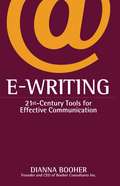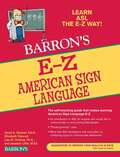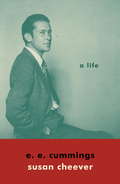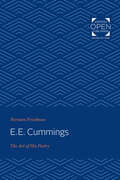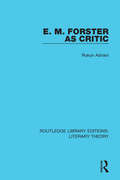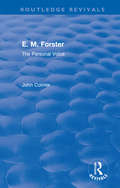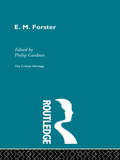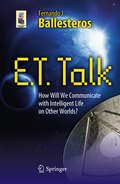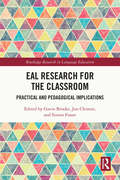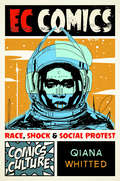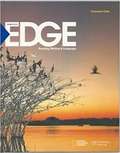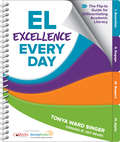- Table View
- List View
E-Government: Information, Technology, and Transformation (Advances In Management Information Systems Ser.)
by Hans J SchnollThis book presents a citizen-centric perspective of the dual components of e-government and e-governance. E-government> refers to the practice of online public reporting by government to citizens, and to service delivery via the Internet. E-governance represents the initiatives for citizens to participate and provide their opinion on government websites. This volume in the Public Solutions Handbook Series focuses on various e-government initiatives from the United States and abroad, and will help guide public service practitioners in their transformation to e-government. The book provides important recommendations and suggestions oriented towards practitioners, and makes a significant contribution to e-government by showcasing successful models and highlighting the lessons learned in the implementation processes. Chapter coverage includes: Online fiscal transparency Performance reporting Improving citizen participation Privacy issues in e-governance Internet voting E-government at the local level
E-Writing
by BooherAre you guilty of e-mail "trigger finger"? Do you constantly "cc" people you never even see? What are today's rules for conducting business over the Internet? Now, The Elements of Style meets "the Miss Manners of memos" in the ultimate writing guide for the digital age. In an era when written communication in the workplace is more crucial than ever, at a time when many professionals all but completely eschew face-to-face dealings, E-writing is poised to become the new bible of business writing. Accessible and inviting, this Web-savvy "how-to" book promises to transform anxious e-mail hacks and mediocre memo writers into eloquent electronic scribes in no time at all. Inside, you will learn how to: combat counterproductive e-mail habits write authoritatively and persuasively, with a clear message that generates quick action handle e-mail and letter correspondence efficiently and effectively select an appropriate style for the audience you're addressing heighten your professional image, self-confidence, and career prospects. Practicing what she preaches, award-winning communicator and bestselling author Dianna Booher writes in a refreshingly straightforward style and has organized E-writing to make on-the-spot referencing a snap. Keep it handy; refer to it often -- and your online mailbox will never be the same again.
E-Z American Sign Language, 3rd Edition (Barron's E-Z Series)
by Elizabeth Stewart David Stewart Lisa DimlingA Simon & Schuster eBook. Simon & Schuster has a great book for every reader.
E-books and ‘Real Books’: Digital Reading and the Experience of Bookness
by Laura DietzOn any given day, millions of people will read e-books. Yet many of us will do so while holding them apart from 'real books'. The fact that a book can be worthy – of our time, money, respect, even love – without being 'real' is a fascinating paradox of twenty-first century reading. Drawing on original data from a longitudinal study, Laura Dietz investigates how movement between conceptions of e-books as ersatz, digital proxy, and incomplete books serves readers in unexpected ways. The cultural value of e-books remains an area of intense debate in publishing studies. Exploring the legitimacy of e-books in terms of their 'realness' and 'bookness', Dietz enriches our understanding of what e-books are, while also opening up new ways of thinking about how we imagine, how we use, and what we want from books of every kind. This title is also available as Open Access on Cambridge Core.
E. B. White: The Essayist as First-Class Writer
by G. Douglas AtkinsThis is the first book-length critical study of E. B. White, the American essayist and author of Stuart Little, Charlotte's Web, The Trumpet of the Swan . G. Douglas Atkins focuses on White and the writing life, offering detailed readings of the major essays and revealing White's distinctiveness as an essayist.
E. E. Cummings
by Susan CheeverFrom the author of American Bloomsbury ("Beguiling" --Publishers Weekly), Louisa May Alcott ("Fascinating . . . Another splendid piece of work with hidden depths by Susan Cheever"--Michael Korda), and Home Before Dark ("Moving and brilliantly restrained"--The New York Times Book Review), a major reassessment of the life and work of the novelist, painter, and playwright considered to be one of America's preeminent twentieth-century poets, our generation's beloved heretic. At the time of his death in 1962, at age sixty-eight, he was, after Robert Frost, the most widely read poet in the United States. E. E. Cummings was and remains controversial. He has been called "a master" (Malcolm Cowley); "hideous" (Edmund Wilson). James Dickey called him a "daringly original poet with more vitality and more sheer uncompromising talent than any other living American writer." In Susan Cheever's rich, illuminating biography we see Cummings's idyllic childhood years in a mythic part of Cambridge, Massachusetts (the Cummings house was within calling distance of Harvard professor William James, who first introduced Cummings's parents); his Calvinist father--distinguished Harvard professor and sternly religious minister of the Cambridge Congregational Church; his mother--loving, attentive, a source of encouragement, the aristocrat of the family, from Unitarian writers, judges, and adventurers. We see Cummings--slight, agile, playful, a product of a nineteenth-century New England childhood, bred to be flinty and determined; his love of nature ("here my enormous smallness entered Her illimitable being"); his sense of fun, laughter, mimicry; his desire from the get-go to stand conventional wisdom on its head, which he himself would often do, literally, to amuse. At Harvard, he roomed with John Dos Passos; befriended Lincoln Kirstein; read Latin, Greek, and French; earned two degrees; discovered alcohol, fast cars, and burlesque at the Old Howard Theater; and raged against the school's conservative, exclusionary upper-class rule by A. Lawrence Lowell. In Cheever's book we see that beneath Cummings's blissful, golden childhood the strains of sadness and rage were already at play. He grew into a dark young man and set out on a lifelong course of rebellion against conventional authority and the critical establishment, devouring the poetry of Ezra Pound, whose radical verses pushed Cummings away from the politeness of the traditional nature poem toward a more adventurous, sexually conscious form. We see that Cummings's self-imposed exile from Cambridge--a town he'd come to hate for its intellectualism, Puritan uptightness ("the Cambridge ladies," he wrote, "who live in furnished souls"), racism, and self-righteous xenophobia--seemed necessary for him as a man and a poet. Headstrong and cavalier, he volunteered as an ambulance driver in World War I, working alongside Hemingway, Joyce, and Ford Madox Ford . . . his ongoing stand against the imprisonment of his soul taking a literal turn when he was held in a makeshift prison for "undesirables and spies," an experience that became the basis for his novel, The Enormous Room, of which F. Scott Fitzgerald wrote: "Of all the work by young men since 1920--one book survives." We follow Cummings as he permanently flees to Greenwich Village to be among other modernist poets of the day--Marianne Moore, Hart Crane, Dylan Thomas--and we see the development of both the poet and his work against the backdrop of modernism and through the influences of his contemporaries: Stein, Amy Lowell, Joyce, and Pound.Cheever's fascinating book gives us the evolution of an artist whose writing was at the forefront of what was new and daring and bold in an America in transition.(With 28 pages of black-and-white images.)From the Hardcover edition.
E. E. Cummings: The Art of His Poetry
by Norman FriedmanOriginally published in 1960. In E. E. Cummings: The Art of His Poetry, Norman Friedman argues that critics who have focused on what Cummings's poetry lacks have failed to judge Cummings on his strengths. Friedman identifies a main strength of Cummings as his being a "sensual mystic." The book unpacks Cummings's subject matter, devices, and symbolism, ultimately helping readers develop a deeper understanding and appreciation of Cummings's work.
E. L. Doctorow (Routledge Library Editions: Modern Fiction #20)
by Paul LevineDuring his lifetime E. L. Doctorow was a remarkable phenomenon among contemporary American novelists. He was a serious writer who was popular, a political writer who was a stylist, an original writer who was highly eclectic and an historical writer who invented the past. In this study, originally published in 1985, Paul Levine follows Doctorow’s progress as a novelist and traces the development of certain themes that recur in his work including the relationships between history and imagination, between high and popular culture and between political content and radical style. He also examines Doctorow’s notion of the writer as witness and actor and of writing as a subversive activity, two concerns which link him with important writers in Europe and Latin America. The book should provide a valuable and comprehensive coverage of his work to date, including the films of Ragtime and The Book of Daniel.
E. M. Forster and Music
by Tsung-Han TsaiThis book examines the political resonances of E. M. Forster's representations of music, offering readings of canonical and overlooked works. It reveals music's crucial role in his writing and draws attention to a previously unacknowledged eclecticism and complexity in Forster's ideological outlook. Examining unobtrusive musical allusions in a variety of Forster's writings, this book demonstrates how music provided Forster with a means of reflecting on race and epistemology, material culture and colonialism, literary heritage and national character, hero-worship and war, and gender and professionalism. It unveils how Forster's musical representations are mediated through a matrix of ideas and debates of his time, such as those about evolution, empire, Britain's relationship with the Continent, the rise of fascism, and the emergence of musicology as an academic discipline.
E. M. Forster as Critic (Routledge Library Editions: Literary Theory #3)
by Rukun AdvaniThis title, first published in 1984, is a study of E. M. Forster as a liberal-humanist thinker and socio-literary critic. Advani discusses Forster’s ideas on man, society, politics, religion, art, aesthetics, fiction and literary criticism. The author examines why Forster was impelled from fiction towards socio-literary criticism and propaganda for art within the political and cultural context of post-Great War Britain. The book argues for Forster’s continuing importance as much more than a skilful novelist. It will be of interest to students of English cultural history, literary theory and criticism, and the work of E. M. Forster.
E. M. Forster: The Personal Voice (Routledge Revivals)
by John ColmerOriginally published in 1975, E. M. Forster: The Personal Voice draws on information about the life and works of E. M. Forster that came to light following his death in 1970. Exploring in particular the publication of Maurice in 1971, The Life to Come in 1972, and the Forster papers in King's College Library, Cambridge, this volume is an extensive study of E. M. Forster. It provides a comprehensive and detailed overview of Forster's work, his intellectual and literary background, his personality, and the reception of his work. E. M. Forster: The Personal Voice places Forster's works in their social and cultural context and provides an excellent insight into his development as a writer.
E. M. Forster’s Material Humanism: Queer Matters (Routledge Interdisciplinary Perspectives on Literature)
by Nour DakkakThrough attending to the nonhuman, E. M. Forster’s Material Humanism: Queer Matters places Forster’s fiction in conversation with contemporary debates concerned with the intersection of neomaterialism, environmental humanities and queer ecology. The book revisits Forster’s liberal humanism from a materialist perspective by focusing on humans’ embodied activities in artificial and natural environments. By examining the everyday embodied experiences of characters, the book thus brings to the fore insignificant and sometimes overlooked aspects in Forster’s fiction. It also places importance on the texts’ treatment of queer intimacy as an embodied experience that can transcend sexual desire. The book acknowledges nonhuman agency as central to our understanding of queerness in Forster’s texts and studies the representation of formless matters such as dust as a way through which Forster’s ecological concerns arise by linking the fate of oppressed humans with oppressed nonhuman others.
E.H. Norman: His Life and Scholarship
by Roger W. BowenThe ashes of Herbert Norman now lie in the British cemetery at Rome, near those of Shelley and Keats. His distinguished life and tragic death, in April 1957, are recalled and examined in this book by scholars and diplomats from four countries--the United States, Japan, Canada, and Britain.Born in rural Japan the son of a Canadian missionary, Herbert Norman studied at the University of Toronto and went in 1933 to Cambridge University on a scholarship. There, in that intellectual hothouse where it seemed one had to choose politically between communism and fascism as the future of the West, he joined the Communist party--a move that became a crime later in the fixed and 'sightless' (as the editor describes them) eyes of his American accusers.According to Edwin Reischauer, later the US ambassador to Japan, 'his harassment by the American government was unforgiveable.' His suicide in Cairo, while Canadian ambassador to Nasser's Egypt during and after the delicate times of the Suez Crisis and the establishment of the UN peace-keeping force, raised broader questions for Lester Pearson--'the right, to say nothing of the propriety, of a foreign government to intervene' in Canadian affairs.Norman was also a renowned historian of Japan. His Japan's Emergence as a Modern State has been called a classic, and between 1946 and 1950, as head of the Canadian Liaison Mission in Tokyo, he was a close and friendly adviser to General Douglas MacArthur in his efforts to reconstitute that country. Both this work and his writings on Japan were sympathetic to human freedoms and democracy, and they too became controversial as sides congealed in the Cold War. Five papers in this book assess Norman's scholarly work in the historiography of Japan.Four lecture papers by Norman (three previously unpublished) are included which show his change from 'a doctrinaire Marxist to a Jeffersonian Liberal,' a change historians can accept as fact whereas intelligence agencies could not and remade Norman into a communist. He was not a spy, the editor concludes, and should be remembered as the hero of a modern tragedy.
E.J. Pratt: Letters
by Elizabeth A. Popham David G. Pitt E.J. Pratt LibraryThis edition of E.J. Pratt’s letters is the final volume in the Collected Works series. Because of Pratt’s role in the making of Canadian culture between and after the World Wars, his correspondence highlights key moments in our cultural history and provides a view of the enterprise from its very centre. The letters take us into his "workshop," illuminating the research behind his distinctive documentary long poems and the social nature of his creative production. They also reveal the complex network of writers, critics, artists and political figures of which Pratt was a part, the evolution of the Canadian book trade from the 1920s through to the early 1960s, and the emergence of radio (and specifically, of the Canadian Broadcasting Corporation) as a tool for forging national identity. Pratt's correspondence both confirms the public persona of one of Canada’s first literary celebrities and provides glimpses of the private character behind the mask.
E.M. Forster
by E. M. ForsterThis set comprises 40 volumes covering 19th and 20th century European and American authors. These volumes will be available as a complete set, mini boxed sets (by theme) or as individual volumes. This second set compliments the first 68 volume set of Critical Heritage published by Routledge in October 1995.
E.S. Dallas in The Times
by Jenny Bourne Taylor Graham LawThis volume comprises of a substantial selection of E.S. Dallas’s journalism in The Times. Although his reviews were crucial not only in forging the literary reputations of upcoming writers such as different as George Eliot and Mary Elizabeth Braddon, but also in recalibrating the response to well-established authors such as Tennyson and Dickens, Eneas Sweetland Dallas (1827-79) remains arguably the most unjustly neglected of mid-Victorian critics. Although Dallas wrote for many other periodicals, it was his reviews in The Times that had the greatest impact on both the market for books and literary culture in the mid-Victorian period. This collection brings together an anthology of his contributions, as well as a newly written introduction, a comprehensive listing of the articles he submitted to The Times, critical apparatus to contextualise the materials, and a detailed chronology, reappraising Dallas’ biography. This volume will be of great interest to students and scholars of literary history.
E.T. Talk
by Fernando J. BallesterosWill it be possible to communicate with intelligent extraterrestrial life forms if we find them? How could we establish this communication, where would we begin? What does it mean to say that mathematics is a universal language? How could math be used to communicate with ETs? This book summarizes the work of SETI, the Search for Extraterrestrial Intelligence, and other search programs and considers the implications of, and concerns about, their possible success. Surely the next step after finding life elsewhere would be to try to communicate with it. The author of this book will suggest concrete ways to approach this problem. This book, published in Spanish first, tells us what scientists currently know about the origin of life and its possible presence in the rest of the universe. It also describes the various methods used today to search for life in the universe. But the major focus of the book is on communicating with ET and, using animals on Earth as an example, why we should feel encouraged that we will be able to do just that. The author even provides step by step instructions in a kind of language that could be used to converse with intelligent alien beings.
E.T.: The Extra Terrestrial, Star Wars: A New Hope (Readers' and Writers' Genre Workshop Ser.)
by Cynthia Swain Lucy ForteNIMAC-sourced textbook
EAL Research for the Classroom: Practical and Pedagogical Implications (Routledge Research in Language Education)
by Gavin Brooks Jon Clenton Simon FraserWith an estimated 1.6 million English as an Additional Language (EAL) learners in the UK, and over 5 million in the USA, EAL research is urgently needed to inform practice. This edited volume investigates the multifaceted elements that shape EAL pedagogy and research in a variety of settings and research areas including linguistic ability influences on subject-specific skills, integrating learners’ home languages into classroom environments, and the importance of supporting EAL teachers in the classroom. In doing so, the contributors provide an international perspective on the emerging field of EAL research. The research-based chapters detail fundamental concerns related to EAL learner education. The text is composed of three parts: Part 1 explores the question of what is EAL and how a definition can shape policy construction; Part 2 examines the challenges EAL learners face in the classroom, including the use of first languages and the relative impact learner language proficiency has on subject-specific classes; and Part 3 investigates concerns relating to supporting EAL teachers in the classroom. The volume draws on researcher expertise from a variety of universities and institutions worldwide. It explores diverse language backgrounds in multilingual contexts. It covers empirical studies with pedagogical, policy and further research implications. The volume represents a single resource invaluable for EAL teachers, trainers and trainees, as well as researchers in the field of education, language learning and teaching, bilingualism and multilingualism, and second language acquisition.
EC Comics: Race, Shock, and Social Protest (Comics Culture)
by Qiana WhittedEntertaining Comics Group (EC Comics) is perhaps best-known today for lurid horror comics like Tales from the Crypt and for a publication that long outlived the company’s other titles, Mad magazine. But during its heyday in the early 1950s, EC was also an early innovator in another genre of comics: the so-called “preachies,” socially conscious stories that boldly challenged the conservatism and conformity of Eisenhower-era America. EC Comics examines a selection of these works—sensationally-titled comics such as “Hate!,” “The Guilty!,” and “Judgment Day!”—and explores how they grappled with the civil rights struggle, antisemitism, and other forms of prejudice in America. Putting these socially aware stories into conversation with EC’s better-known horror stories, Qiana Whitted discovers surprising similarities between their narrative, aesthetic, and marketing strategies. She also recounts the controversy that these stories inspired and the central role they played in congressional hearings about offensive content in comics. The first serious critical study of EC’s social issues comics, this book will give readers a greater appreciation of their legacy. They not only served to inspire future comics creators, but also introduced a generation of young readers to provocative ideas and progressive ideals that pointed the way to a better America.
ECCE Romani 2: A Latin Reading Program
by Lin Wangcontains Chapters 28 through 54 of the storyline, plus outstanding support for Word Study, Roman Life, Frontier Life, History, and Mythology
EDGE: Reading, Writing & Language
by Michael W. Smith Deborah J. Short David W. Moore Alfred W. Tatum Jr. René SaldañaEdge is a leveled core reading/language arts program designed for striving readers and ESL students in grades 9-12. Edge is designed to help prepare all students for college and career success with dynamic National Geographic content and authentic and multicultural literature. Edge was built around relevant and motivating content, preparation for success on the new CCSS tests, and systematic and focused teaching materials, all while incorporating and covering the Common Core State Standards. The reading selections in Edge were specifically chosen to engage adolescent striving readers, get students excited about reading, and create a context for discussion and learning. Program authors Alfred Tatum, Michael Smith, and David Moore have conducted decades of research on how to select literature that engages and inspires adolescent striving readers as well as incorporate best, research-based teaching practices to ensure success for all students, increase reading and comprehension levels, and prepare students for success beyond the high school classroom.
EFL Pedagogy as Cultural Discourse: Textbooks, Practice, and Policy for Arabs and Jews in Israel
by Muzna Awayed-BisharaThis book offers unique insight into the role that English as a Foreign Language (EFL) discourse plays in shaping the ideological terrain of contemporary Israel/Palestine through constructing the subjectivities of those who plan, teach, and learn it. While the EFL curriculum is uniform across Hebrew and Arabic-speaking educational contexts, this book traces how its cultural content reproduces dominant hegemonic ideologies, and perpetuates the social misrepresentations of the Other that underlie inequality. The language of English teaching textbooks, the way that students understand their content, and the official policy documents that guide both EFL materials and teaching practices, are all thoroughly examined through Critical Discourse Analysis. The theoretical and methodological foundation for further cross-cultural studies of Anglo-centric and other forms of hegemonic EFL discourses within local/global contexts, and for contesting their ideological effects, are also laid down. Through promoting a transformative EFL cultural discourse which hopes to position EFL teaching as a possible arena for effecting social change, this book offers a unique context for students, scholars, and educators interested in linguistics, CDA, cultural discourse studies, English in local/global contexts, and EFL education.
EIL Education for the Expanding Circle: A Japanese Model (Routledge Studies in World Englishes)
by Nobuyuki HinoThe teaching of English in the Expanding Circle, traditionally called EFL countries, has long been regarded as having no choice but to follow Inner Circle or Anglo-American norms, both in pedagogy and language models. This situation is in sharp contrast with that of the Outer Circle, or ESL countries, where the WE (World Englishes) paradigm, coupled with post-colonialism, has liberated the users of indigenous Englishes from the norms of Anglophone native speakers. Employing. Japan as a primary sample, this book proposes a new paradigm of EIL (English as an International Language) education, by integrating relevant paradigms such as WE and ELF (English as a Lingua Franca), which enables users of English from the Expanding Circle to represent their own voices in international communication.. Various examples of actual classroom practice in EIL are also presented, bridging the longstanding gap between theory and practice in this field.
EL Excellence Every Day: The Flip-to Guide for Differentiating Academic Literacy
by Tonya W. SingerTake the Flip-to Book Tour! You have to see this book to believe this book. And once you use this book it will quickly become your most treasured teaching resource. What exactly is so remarkable? All of the best teaching tools in language and literacy are at your fingertips! Just flip to that strategy you want to learn or that literacy goal you want to reach for a wealth of ready-to-use resources to actively engage learners, build academic language, and strategically support literacy instruction. Much more than a resource for EL specialists, EL Excellence Every Day is written for every teacher, with a singular focus on improving the ways we all differentiate literacy instruction. Busy teachers especially will appreciate: Over 85 flip-to strategies that help you engage and support all learners 200+ prompts and linguistic scaffolds to facilitate academic conversations connected to specific literacy goals Lesson-ready resources for essential literacy goals: anticipate before reading, read to understand, read to analyze and infer, and write with text evidence Formative assessment tasks and if/then charts for personalizing teaching to every student Differentiation guides that demonstrate how to adjust supports across EL proficiency levels Intuitive, color-coded design so you can find what you need, when you need it No one lesson or strategy is ever the perfect solution for every student. No one student learns in the same way. If there’s one universal truth in teaching it’s that every child is unique. Devour this book and soon enough you’ll provide the excellent literacy instruction each and every student deserves each and every day. "We need resources that clearly and quickly help us to meet diverse instructional needs every day in every classroom. Tonya Ward Singer’s EL Excellence Every Day: The Flip-to Guide for Differentiating Academic Literacy is such a resource." --JEFF ZWIERS, from the foreword

